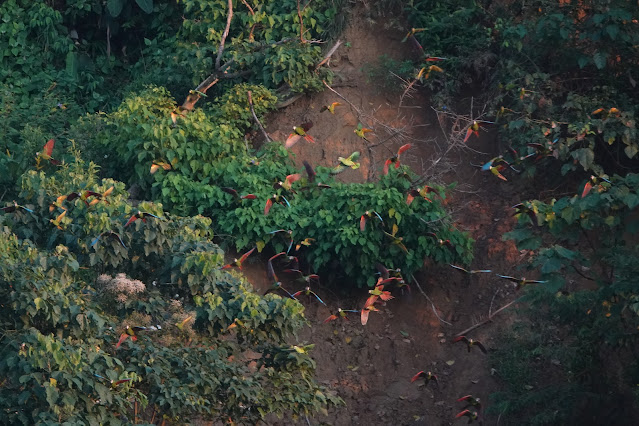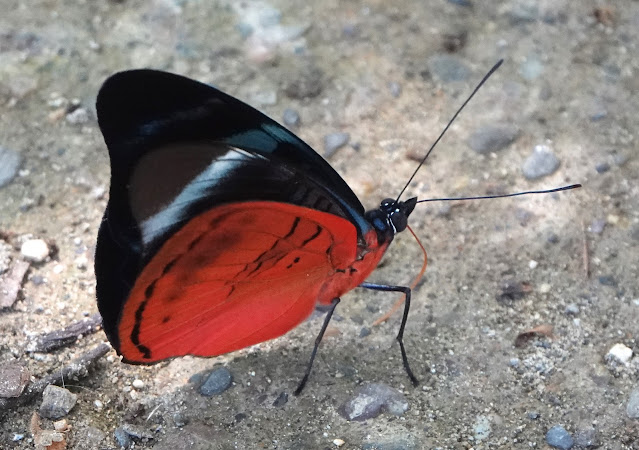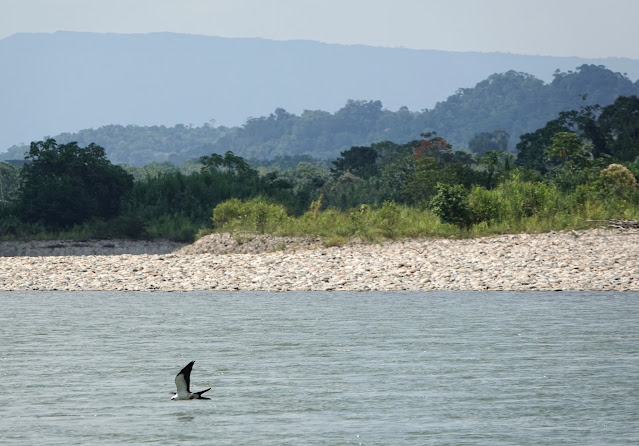We left at 4am to make it to the clay lick at sunrise. It required a one hour drive to Atalaya then 40 minutes in a motorized canoe in the dark up the Madre de Dios River. Before we even beached the canoe, we could hear hundreds of parrots calling- seven different species it turned out of parrots, parakeets and macaws! The birds use clay licks in this area to neutralize the alkaloids from the seeds they eat and get needed sodium. It's also a chance to socialize. The Blue and Yellow macaws don't feed from this lick but they perch on the trees above and watch the others. They come around sunrise and only stay for 30-60 minutes.
We saw seven species: Blue-headed Parrot, Yellow-crowned Parrot, Mealy Parrot, Dusky-headed Parakeet, Chestnut-fronted Macaw, Red-and-Green Macaw, White-eyed Parakeet
By the time they left, we'd counted 38 species of birds and our breakfast on the sandbar was ready; crepes with caramel sauce plus fruit, coffee and hot chocolate, yum! As we enjoyed out meal, on the riverbanks in the Amazon Rainforest with macaws flying overhead and the roar of Howler Monkeys in the distance, we marveled at this whole experience, definitely our best breakfast experience ever! We are so thankful for the opportunity to experience these amazing natural events!
Fasciated Tiger-Heron
After breakfast we headed back upriver for a hike through the jungle to Cocha Machuhuasi.
This Capped Heron was the first bird we saw, and what a cool bird it is! During the hike we found the Black-tailed Trogon, Black-fronted Nunbird and Bluish-fronted Jacamar (all pictured below).
Finally we reached Cocha Machuhuasi, where we boarded a bolsa raft. Dozens of brightly colored butterflies floated above the earth. We heard a strange sound and our guide, William, smiled and said, "Horned Screamers!". A few minutes later we spotted them in the vegetation. They were much larger than I expected, about the size of a goose, and check out that horn!
Smooth-billed Ani (above) Yellow-bellied Dacnis (below)
Leaf-cutter Ants busy at work (above). A walking tree (below), grows long "legs" which can eventually, over time move the tree.
We boarded the bolsa rafts to explore the lagoon. Asher did some fishing and though he had some bites, he wasn't able to pull anything in.
At the other end of the lagoon is a very high platform providing an excellent view and the perfect place to rest.
William and I went looking for birds while they rested and later met them back at the rafts.
We hiked back to the boat and found a place upriver to enjoy our lunch.
Lunch was seasoned rice, chicken, and egg, wrapped in banana leaves. The perfect "to go" container!
I found some cool caterpillars and butterflies after we ate.
Oropendelas build these hanging nests.
It was fun to see one of my favorite Florida birds, the Swallow-tailed Kite soaring and diving along the river. They spend summer in Florida and winter in South America. I could very well see this same bird in both locations! Some have been fitted with a GPS device, so you can actually track their migration on your computer!
We were given the option of hiking to another location, but decided to spend time relaxing along the river instead, giving Asher a chance for more fishing and me a chance to explore among the rocks.
I found a few interesting spiders and flowers.
Journey found some quicksand. Why do my kids love playing in quicksand?
We spotted a few more birds on the way back to the port. The White-banded Swallow, White-winged Swallow and an Amazon Kingfisher (pictured).
This is the port at Atalaya, not at all what I had imagined! This is basically where Manu Road ends and to get deeper into the Amazon, one must take a boat from here. My friend, Scott, used to work at a research station deep within Manu, and in the 80s, his journey from Cusco to Cocha Cashu would take 2 days in the bed of a pickup truck traveling Manu Road, 2-3 days in dugout canoes on this river, then a hike to the station!) It was there he set the record for most birds seen in a single day without a motorized vehicle- 331 species! And they only covered 1 square mile! Watch him tell the story here.
On our way back to Guadalupe Lodge, we stopped to admire this beautiful view of the Madre de Dios river. Fantastic!
How often do you see a view like this through your vehicle window?
We made one last stop for a special bird. Do you see it?
It's white and perched right at the bend of the tree. It's a Great Potoo!




































































































No comments:
Post a Comment